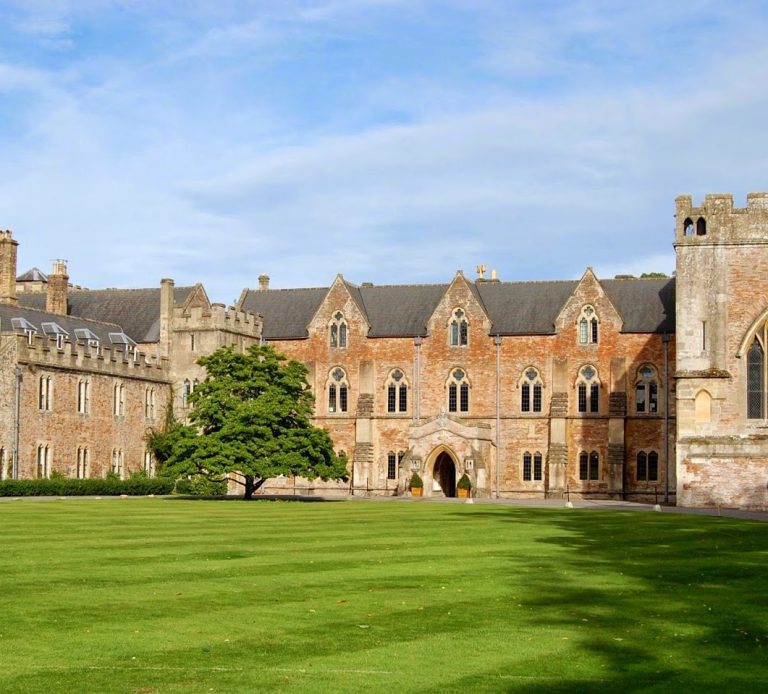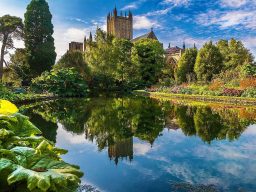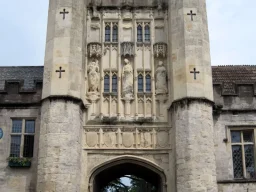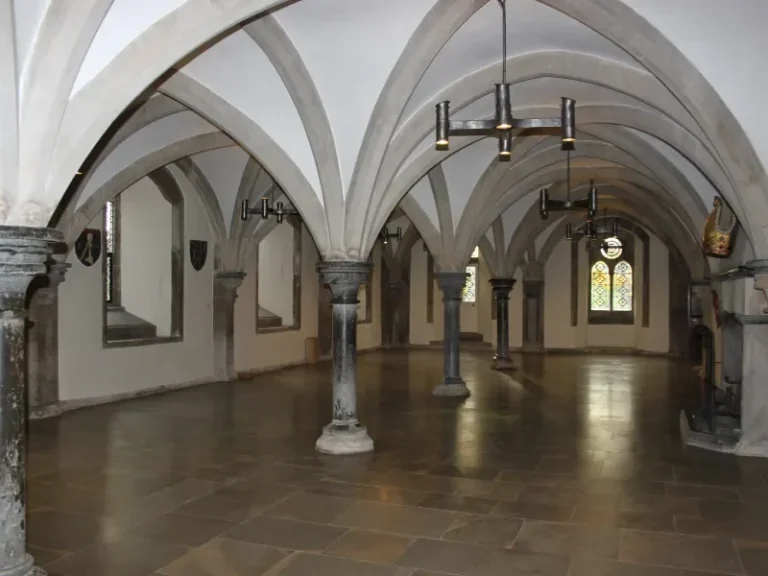The Bishop's Palace
The Bishop's Palace, Wells.
Information by The Bishop's Palace website.
The Bishop’s Palace and Gardens in Wells, Somerset has been home to the Bishops of Bath and Wells for over 800 years and this stunning medieval palace, along with its 14 acres of RHS partner gardens, is now open for all to enjoy. The site dates from the early-thirteenth century when Bishop Jocelin received a crown licence to build a residence and deer park on land to the south of the Cathedral of St Andrew. The moat has also been home to mute swans since the 1800s.

Map of the grounds of the Bishop's Palace. We will meet at the arch, known as The Bishop's Eye, at the bottom of the map. Click the map (or here - pdf map) for a pdf version.

Pass through the archway, known as the Bishop’s Eye, from the market square, and you will see with a moat, gatehouse with drawbridge and ramparts topped with crenellations.
Crenellations are the "up and down" parapet walls common in castles, people sometimes call them "castleations". You may remember from Stratford that, to this day, you still require a licence, from the king, to crenellate, as it is seen as a challenge to the throne.
Today, you are welcome to visit, but Bishop Ralph was more wary about his callers. The mid 1300s were a time of plague, famine and political war and he built these ramparts for protection and also as a symbol of authority and power. The ramparts provide spectacular views, to Glastonbury Tor, the Mendips and the Cathedral.
The moat also served a practical purpose: it played, as it does now, a key role in taming the damp, marshy and often flooded land which surrounded the Palace. Today, the moat is home to a collection of waterfowl, a family of Kingfishers and an otter that passes through throughout the year.
The Bishops Palace and Grounds
A taster of what you will see on the tour.

Swans ring a bell for food at The Bishop's Palace.
A rope hangs from the gatehouse of The Bishop's Palace in Wells for swans to ring for food.
The tradition goes back to the 1850s when Bishop Eden's daughter Maria taught a pair of swans to ring a bell when they wanted to be fed.
The adults teach their young to ring the bell.
Visitors from around the world come to see the famous swans.
This occurs around mid-day but they are wild animals so their watches aren't accurate.

This building is one of the most impressive historic bishop’s houses still in use in England and a striking example of how bishops in medieval times used buildings to demonstrate their political power.
Begun around 800 years ago, successive bishops have left their mark on the Palace. The original Palace was built for Bishop Jocelin and contains the beautifully vaulted Undercroft and, up the staircase, to what would have been the rooms where he entertained, worked, dined and slept.
A walk along the Long Gallery gives an intriguing insight into past bishops via their portraits. Other rooms contain exhibitions ranging from art to history and to artefacts all linking into the spiritual role of this site.
Walking around the exterior of the Palace you can see the notable additions to the Palace, instigated by succeeding bishops: Bishop Burnell’s late 1200s Chapel and Great Hall, Bishop Bekynton’s mid-1400s north range and tower – now home and working offices of the Bishop – and the addition by Bishop Bagot of an additional storey to the original medieval building, about 170 years ago.
The Bishop’s Chapel



This unusually grand, episcopal chapel, built between 1275 and 1292 for Bishop Burnell, Lord Chancellor under Edward I, has been used for centuries by the Bishops of Bath and Wells, and their households, for private prayer. The architecture is a great example of the Early English Style.
Here you can sit in peace and quiet and take in the chapel’s beautiful proportions, the patterns of stone tracery, and exceptional medieval carved detail of the vaulted ceiling and sedilia. Tall windows fill the chapel with light which spills through stained glass rescued from French churches damaged or abandoned after the Revolution of 1789: spot intriguing fragments of lost scenes and symbols. Modern additions include the Somerset made, early 20th century pews and a 21st century heraldic frieze displaying the bishops’ arms.
Bishop Burnell’s splendid dining and entertaining hall, was built in the 1280s alongside his chapel. Although only two walls and the four corner turrets survive, it is still one of the most impressive examples of a medieval open hall; its huge size reflects the power held by Bishop Burnell as a leading statesman of his time. It was the third largest secular hall in England after Canterbury and Westminster Palace. Built in the Early English style, elements of this can be seen in the remaining wonderfully large windows, which offer beautiful framed views of the cathedral, and the crenellations.
It is possible to imagine entering the building through an impressive two storey porch into a large open space; this was church-like with aisles on each side of a nave. At one end was a pantry and buttery and above these the bishop’s private rooms (the ‘solar’) and at the other end, the ‘high table’. Adjacent to the solar was the still-existing ‘garderobe’ which has been described as the ‘finest medieval loo in England’.
As with many other fine buildings in England, the English Reformation marked the end of the illustrious role of the Great Hall. During the second half of the 1500s it was stripped of its lead roof and the weather began its corrosive effect on the rest of the building. In the 19th century Bishop Law demolished two of the walls and used the remaining shell of the Great Hall in landscaping to create the Garden which can be enjoyed today.
We need your consent to load the translations
We use a third-party service to translate the website content that may collect data about your activity. Please review the details in the privacy policy and accept the service to view the translations.











